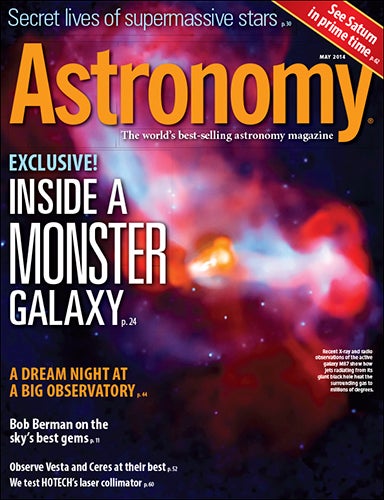
Waukesha, Wis. – Elliptical galaxy M87 is a fascinating astronomical laboratory that sits some 50 million light-years from Earth. It lies at the center of the Virgo cluster of galaxies and has an active supermassive black hole at its core. Over the past 15 years, astronomers have found that this black hole heats gas and ceases star formation within not just M87 but also its host cluster. This galaxy harbors other surprises, and mysteries, too, which Contributing Editor Steve Nadis explores in “Peering inside a monster galaxy.”
M87’s central black hole is some 6 billion times more massive than our Sun. This huge mass also has an enormous gravitational pull, which funnels nearby material into a disk around the black hole before some of that gas disappears into the massive object. For decades, a pair of astrophysicists with the Smithsonian Astrophysical Observatory and their team has been working to understand M87’s active core. And with the help of NASA’s Chandra X-ray Observatory, they haven’t been disappointed. The scientists have revealed new findings about how the black hole heats the surrounding gas, how long it’s been in outburst, how it balances with its surroundings, and much more.
To learn more about M87, what goes on near its central black hole, and how scientists figured this information out, pick up the May 2014 issue of Astronomy, on newsstands April 1.
“Secret lives of supermassive stars”
The most massive stars in the universe live fast and die young. They burn through their material (at least 100 or more times the mass that the Sun holds) at a much faster rate, and therefore live for just millions of years compared to the Sun’s 10 billion-year lifetime. Intense winds of particles and radiation spew from these supermassive stars, stripping away anywhere between 10 and 50 solar masses of material during the stars’ lives. And when they die, these suns erupt in huge outbursts called hypernovae – brilliant blasts that can be visible from billions of light-years away. Learn more about the exciting lives and deaths of these behemoth suns in “Secret lives of supermassive stars” by Yvette Cendes.
“24 gems near the North Celestial Pole”
For those that observe from north of 25° north latitude, Senior Editor Michael E. Bakich has put together a list of deep-sky objects that remain visible throughout the entire year. These two-dozen star clusters, nebulae, and galaxies lie near the North Celestial Pole and thus never fall below the horizon from northerly viewpoints. In “24 gems near the North Celestial Pole,” Bakich provides observing information and tips, plus a chart to find your way around the sky. Take time this spring to observe these deep-sky treats – or save this list for any other time of the year.
“See Saturn in prime time”
A favorite object to observe, Saturn reaches its 2014 peak May 10. The ringed planet will glow at magnitude 0.1 when it hits the point in its orbit where it lies opposite the Sun as seen from Earth – that means we’ll see Saturn’s disk 100 percent illuminated. Senior Editor Michael E. Bakich describes what you’ll see on the planet through a small telescope, what the different patterns on Saturn’s disk result from, and of course how to see the popular observing target in “See Saturn in prime time.”
May night-sky events visible without optical aid
- May 4 – The Moon passes 5° south of Jupiter.
- May 6 – The Eta Aquariid meteor shower peaks.
- May 10 – Saturn reaches its 2014 peak and shines at magnitude 0.1.
- May 25 – The Moon passes 2° north of Venus.
Also in the May 2014 Astronomy
- “A dream night with the Discovery Channel Telescope” – Few observers are able to use an instrument with a 14-foot mirror. For one night, Tom Polakis saw how the universe looks through such a behemoth.
- “View Ceres and Vesta at their best” – Take time this spring to tract down the two brightest asteroids, which reach opposition and peak visibility within two days and 3° of each other.
- “Astronomy tests a great new collimator” – Align your SCT quickly, easily, and in broad daylight with HOTECH’s Advanced CT Laser Collimator.
- “The Sky this Month” – Exclusive pullout star charts will guide you through the night sky.
- The May issue of Astronomy also includes Astro News, Ask Astro, Snapshot, Breakthrough, Bob Berman’s Strange Universe, Stephen James O’Meara’s Secret Sky, Glenn Chaple’s Observing Basics, Adam Block’s Cosmic Imaging, Erika Rix’s Astro Sketching, Cosmic World, Letters, Web Talk, New Products, Reader Gallery, and Final Frontier.
Astronomy offers you the most exciting, visually stunning, thorough, and timely coverage of the heavens above. Each monthly issue includes expert science reporting, vivid color photography, complete sky-event coverage, spot-on observing tips, informative equipment reviews, and more. All of this comes in an easy-to-understand user-friendly style that’s perfect for astronomers at any level. Contact Astronomy, the world’s best-selling astronomy magazine, at 262.796.8776 or email editor@astronomy.com.









